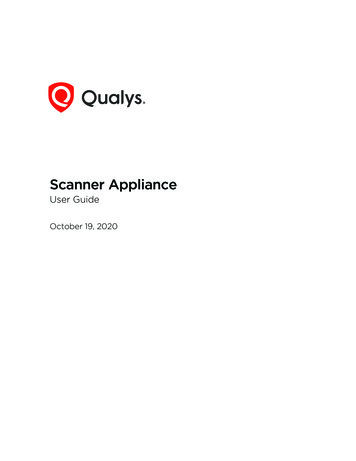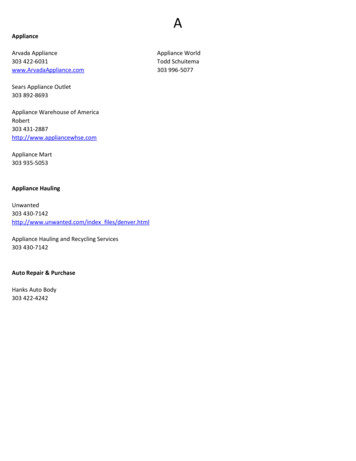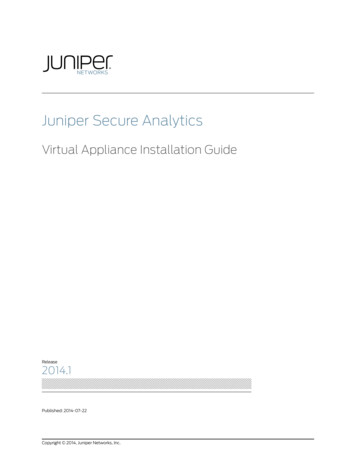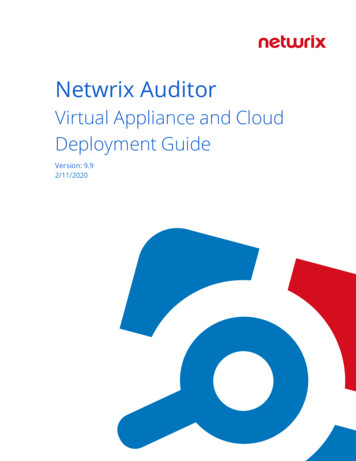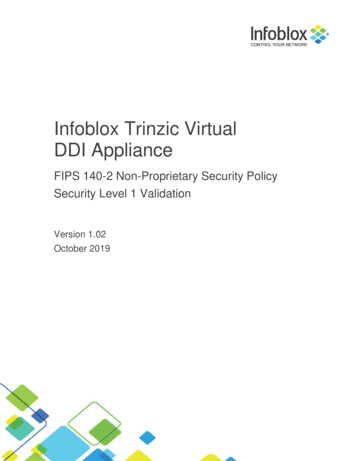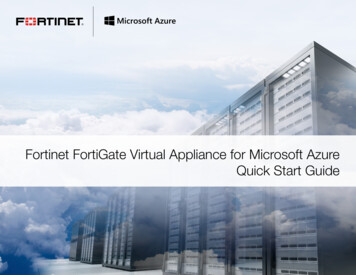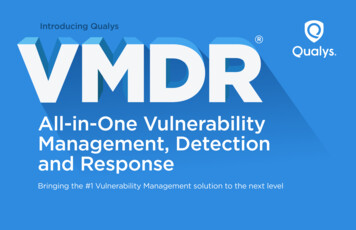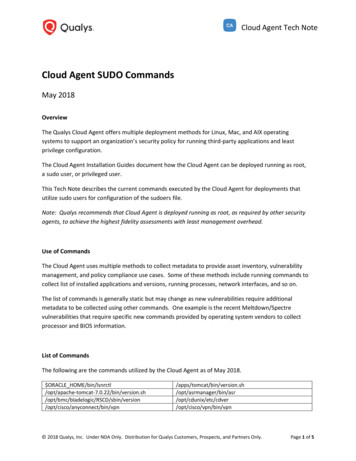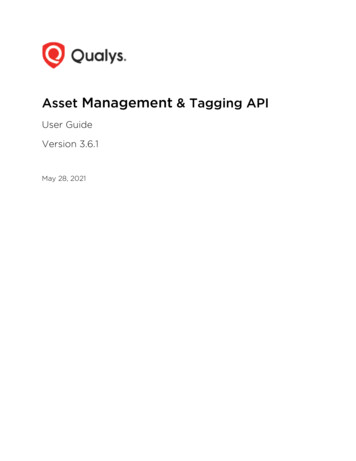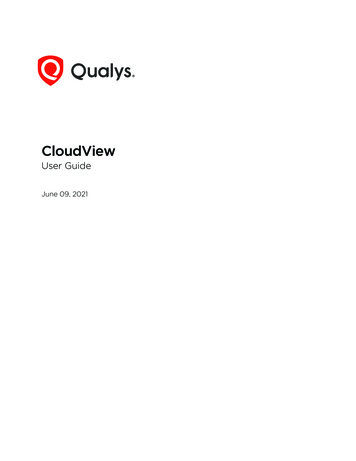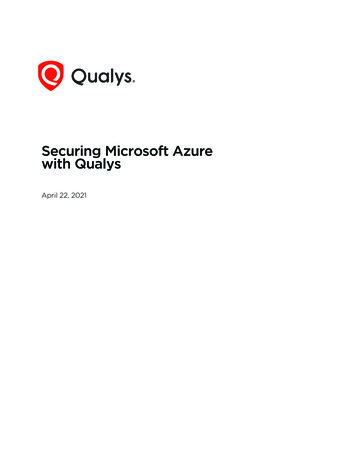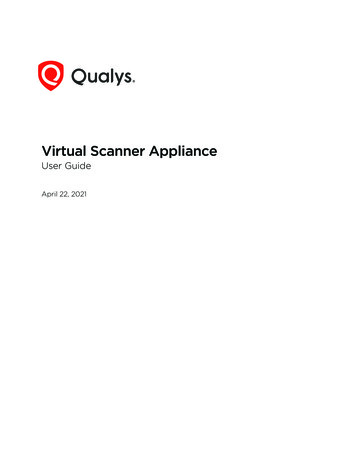
Transcription
Virtual Scanner ApplianceUser GuideApril 22, 2021Verity Confidential
Copyright 2012-2021 by Qualys, Inc. All Rights Reserved.Qualys and the Qualys logo are registered trademarks of Qualys, Inc. All other trademarksare the property of their respective owners.Qualys, Inc.919 E Hillsdale Blvd4th FloorFoster City, CA 944041 (650) 801 6100
Table of ContentsAbout this guide. 3About Qualys . 3Qualys Support . 3Get Started . 4It’s easy to add a virtual scanner. 4Add Your Virtual Scanner . 5We recommend one more thing . 10Configuration settings . 11Troubleshooting . 16Why do I see an Activation Code? .Communications Failure message .Appliance Network Errors .Trouble connecting or seeing the wrong IP returned for your scanner? .316161717
About this guideAbout QualysAbout this guideQualys Virtual Scanner Appliance supports the same global scanning capabilities as ourphysical scanner appliance. The virtual scanner appliance is a stateless, disposableresource which acts as an extension of the Qualys Cloud Platform and is not a separatelymanaged entity. This user guide describes how to get started with using a virtual scannerwith your virtualization or cloud platform.About QualysQualys, Inc. (NASDAQ: QLYS) is a pioneer and leading provider of cloud-based security andcompliance solutions. The Qualys Cloud Platform and its integrated apps help businessessimplify security operations and lower the cost of compliance by delivering criticalsecurity intelligence on demand and automating the full spectrum of auditing,compliance and protection for IT systems and web applications.Founded in 1999, Qualys has established strategic partnerships with leading managedservice providers and consulting organizations including Accenture, BT, CognizantTechnology Solutions, Deutsche Telekom, Fujitsu, HCL, HP Enterprise, IBM, Infosys, NTT,Optiv, SecureWorks, Tata Communications, Verizon and Wipro. The company is also afounding member of the Cloud Security Alliance (CSA). For more information, please visitwww.qualys.comQualys SupportQualys is committed to providing you with the most thorough support. Through onlinedocumentation, telephone help, and direct email support, Qualys ensures that yourquestions will be answered in the fastest time possible. We support you 7 days a week,24 hours a day. Access support information at www.qualys.com/support/3
Get StartedIt’s easy to add a virtual scannerGet StartedIt’s easy to add a virtual scannerYou can add a virtual scanner to your account in just a couple minutes. Then you’ll beready to scan devices and web applications on your internal network.Supported virtualization platformsQualys Virtual Scanner Appliance is packaged and qualifiedfor deployment on a variety of virtualization and cloudplatforms.Desktop/LaptopVMware Workstation, Player, Workstation Player, FusionClient/ServerVMware vSphere: vCenter Server, ESXiCitrix XenServerMicrosoft Windows Server (Microsoft Hyper-V)CloudAmazon EC2-ClassicAmazon EC2-VPCMicrosoft Azure Cloud Platform (ARM)Google Cloud PlatformOpenStackOCI and OCI-ClassicAlibaba Cloud ComputeWant help with choosing the right platform?No problem, just check our Community where you can find all the details about oursupported virtualization platforms, configurations and available distributions.From our CommunityVirtual Scanner Appliance - Platform Qualification MatrixReference - Virtual Scanner Appliance4
Get StartedAdd Your Virtual ScannerAbout managing instancesInstance SizeThe maximum supported size for a scanner instance is 16 CPUs and 16 GB RAM.Instance Snapshots/Cloning Not AllowedUsing a snapshot or clone of a virtual scanner instance to create a new instance is strictlyprohibited. The new instance will not function as a scanner. All configuration settings andplatform registration information will be lost. This could also lead to scans failing anderrors for the original scanner.Moving/Exporting Instance Not AllowedMoving or exporting a registered scanner instance from a virtualization platform (HyperV,VMware, XenServer) in any file format to a cloud platform (AWS, Azure, GCE, OpenStack)is strictly prohibited. This will break scanner functionality and the scanner willpermanently lose all of its settings.What do I need?The Virtual Scanner option must be turned on for your account. Contact Qualys Supportor your Technical Account Manager if you would like us to turn on this option for you.You must be a Manager or a sub-user with the “Manage virtual scanner appliances”permission. This permission may be granted to Unit Managers. Your subscription may beconfigured to allow this permission to be granted to Scanners.Add Your Virtual ScannerStep 1 - Start the WizardGo to Scans Appliances and select New Virtual Scanner Appliance.5
Get StartedAdd Your Virtual ScannerClick Start Wizard, and we’ll walk you through the steps.Step 2 - Choose your virtualization platformGive your scanner a name and tell us the virtualization platform you’d like to use.If you’re a sub-user then you’ll need to pick an asset group that has been assigned to yourbusiness unit by a Manager user. Not seeing any asset groups? Please ask a Manager toassign an asset group (other than the All group) to your business unit.6
Get StartedAdd Your Virtual ScannerStep 3 - Download the ImageThis step applies to virtualization platforms with a scanner appliance image download(i.e. for VMware, Citrix XenServer, etc). Using a cloud platform? Skip to the next step.Locate the Virtual Scanner image on your local system.Interested in QCOW2 format for importing into KVM? Download the OVA image file andconvert it using the qemu-img tool. Learn moreStep 4 - Get your Personalization CodeYou’ll want to copy the code to a safe place (you’ll need it later).7
Get StartedAdd Your Virtual ScannerStep 5 - Complete Configuration Steps for your PlatformFollow the “How to” link on the screen (next to your personalization code) to getstep-by-step instructions for your virtualization platform. The steps will differ slightly foreach platform.Step 6 - Personalize Your ScannerLocal system or serverThese steps apply when you have downloaded a scanner appliance image (i.e. for VMware,Citrix XenServer, etc). You’ll use our Virtual Scanner Console running on yourvirtualization software to complete these steps.Good to know We’ll automatically configure your virtual scanner with DHCP. Do youwant to use a static IP instead? If yes select “Set up network (LAN)” first. Learn morePress the Right arrow to select“Personalize this scanner” and then typein your personalization code.Don’t have your personalization code? Goto Qualys and get it from the Scans Appliances list.Once you enter the code the activationprocess starts and you’ll see the progress.This may take a few minutes to complete.Your virtual scanner must connect to ourCloud Security Platform in order tocomplete the activation and downloadthe latest software versions.8
Get StartedAdd Your Virtual ScannerUpon success you’ll see this scanner’sname and IP address. That’s it! You’veadded your virtual scanner to youraccount.Having trouble with completing theactivation? Click hereGet detailed instructions and best practices from our Community.Learn moreScanner Appliance FAQsConfigure a virtual scanner using VMware (various products)Configure a virtual scanner using Microsoft Hyper-VConfigure a virtual scanner using VMware vSphere (vCenter)Configure a virtual scanner using a laptop connected to the Internet(MiFi)Cloud PlatformThis includes Amazon EC2, Microsoft Azure, Google Cloud Platform, OpenStack, OCI andOCI-Classic and Alibaba Cloud Compute. You’ll enter your personalization code on thecloud platform, as part of the scanner appliance instance configuration. Get detailedinstructions and best practices from our Community.Learn moreConfigure a virtual scanner using Amazon EC2Choosing the Correct Scanner AMI (Amazon Machine Image)Scanning in Microsoft AzureVirtual Appliance in Google Compute Cloud (GCE)Scanning in OpenStackDeploy virtual scanner in Oracle Cloud Infrastructure (OCI)9
Get StartedWe recommend one more thingWe recommend one more thingCheck your virtual scanner status. Go to Scans Appliances, and select your scanner andyou’ll see the preview pane.Tip - It can take a few minutes for the Qualys user interface to get updated after you add anew appliance. Please refresh your browser periodically to ensure that you are seeing themost up to date details.1tells you your virtual scanner is ready. Now you can start internal scans! (Next tothis, you’ll see the busy icon is greyed out until you launch a scan using this scanner).2 - This shows you it’s a virtual appliance.3 - Latest software versions - these are installed as part of the activation.4 - The available capacity will be 100% until you launch a scan. You can come back andcheck this at any time.10
Configuration settingsConfiguration settingsYou might need to customize your configuration, so that your scanner can phone home toour Cloud Security Platform - this is required for successful activation.Network settingsThere are multiple network settings that you can choose for your virtual scanner, likestatic IP address, proxy server, and VLAN tag (for 802.1q trunked port). Just enter thenetwork settings using the Virtual Scanner Console.Having trouble personalizing your scanner? You may need to configure network settingsfirst.How to use a static IP addressYou can choose to configure your appliance with a static IP address instead of DHCP.- using the Virtual Scanner Console go to the main menu- select “Set up network (LAN)”- press the Right arrow to highlight “Enable static IP config on LAN”- press the Right arrow- enter settingsHow do I enter settings? Press the Up and Down arrows to select input fields. Press theRight and Left arrows to scroll within a fields. When you are done, select the last item, forexample “Configure static IP address on LAN?” and type Y to confirm (or type N to cancel).Want to configure a static IP using Amazon EC2? Click here11
Configuration settingsEnable VLAN on LAN (Native/Default VLANs)Native VLAN interface is configured with DHCP settings by default. If you want staticVLAN settings, make sure you’ve already enabled and saved the static IP config on LANbefore continuing.Select the “Enable VLAN on LAN” option in the Virtual Scanner Console if you haveconnected the LAN interface to a 802.1q trunked port and need your virtual scanner to useVLAN tags on the LAN default network. You’ll enter the VLAN tag number (1-4094) youwant to use.Configure VLANs and static routes (in Qualys UI)Configuring VLANs and static routes is supported for all virtual scanner distributions,except cloud platforms like Amazon EC2/VPC, Microsoft Azure and Google Cloud Platform.Log in to Qualys and go to the appliances list (Scans Appliances) and edit the appliancesettings. Up to 4094 VLANs and static routes can be added to each virtual scannerappliance, as long as you are using the latest distribution. You’ll have the latest virtualscanner if you’ve deployed it using scanner image qVSA-2.0.13-1 or later. (If you have anolder version, you can add up to 99 VLANs and static routes.)Don’t see these settings? The VLAN trunking feature must be turned on for your account.Please contact Support or your Technical Account Representative if you’d like us to turn iton for you.Proxy configurationThe Scanner includes Proxy support with or without authentication - Basic or NTLM. TheProxy server must be assigned a static IP address and must allow transparent SSLtunneling. Proxy-level termination (as implemented in SSL bridging, for example) is notsupported. The Scanner does not support Proxy servers in networking environmentswhere the Proxy server IP address is dynamically assigned. SOCKS proxies are notsupported.What are the steps? Access the Virtual Scanner Console. Navigate to “Enable proxy”, pressthe Right arrow and enter proxy settings. You can enter either the IPv4 address or theFQDN for the proxy server. Not seeing the FQDN option? Be sure you have the latestscanner software version.12
Configuration settingsSplit Network configurationBy default the Scanner LAN interface services all traffic to the Qualys Cloud Platform,including management traffic (software updates, health check, scan data upload) andscanning traffic.You have the option to configure a split network configuration for your Scanner byconfiguring the WAN interface using the Virtual Scanner Console. This enables support fornetworks that do not have direct Internet access. Split network configuration also keepsscanned data and internal targets secure by isolating internal LAN traffic from Internettraffic by using the WAN interface.Once configured, management traffic will be routed through the WAN interface andscanning traffic will be routed through the LAN interface. No internal traffic will be routedor bridged to the WAN interface, and no management traffic will be routed or bridged tothe LAN interface.Please review these tips and best practices before you configure split networkconfiguration. Check to be sure that network connection to both the LAN and WAN interfaces onthe Virtual Scanner have been set up properly. The Virtual Scanner must be configured with DHCP or a static IP address on theLAN interface first. Do not configure the LAN and WAN interfaces on the same subnet. This type ofconfiguration is not supported.13
Configuration settingsWhat are the steps? Access the Virtual Scanner Console. Navigate to “Enable WANinterface”, press the Right arrow and provide the required settings. All software updatesand health checks are routed through the WAN interface and scanning traffic is routedthrough the LAN interface.Resize the DiskYou can increase the disk size for your scanner appliance instance at any time, as often asneeded. Stop the instance, find the Hard Disk/Storage option in your Virtual Machinesettings and increase the size of the disk (reducing the size is not supported). Save yoursettings and start up your scanner. Your scanner instance should come up with the newdisk size.Here’s an example from the VMware ESXi/vCenter platform.Convert image to another formatScanner image disks are available in VMDK and VHD formats. You can convert these intoany format supported by the qemu-img tool, for example convert VMDK or VHD toQCOW2 or RAW. The following command provides a list of supported formats:qemu-img -hThe steps below describe how to convert an OVA file (with VMDK disk format) to QCOW2and import it into the KVM hypervisor as a Linux/RedHat Enterprise virtual machine.1) On a Linux system install the qemu-img tool.2) Download the Standard image in OVA format from Qualys (e.g. qVSA.i386-2.2.27-1.ova).3) Extract the .vmdk disk image file from OVA as follows:#] tar xvf qVSA.i386-2.2.27-1.ovaThis will extract a qVSA.i386-2.2.27-1-disk1.vmdk file in the same location.14
Configuration settings4) Convert the .vmdk disk image to .qcow2 format as follows:#] qemu-img convert -f vmdk -O qcow2 sk1.qcow25) Import qVSA.i386-2.2.27-1-disk1.qcow2 into KVM as a Linux/RedHat Enterprise virtualmachine.15
TroubleshootingWhy do I see an Activation Code?TroubleshootingWhy do I see an Activation Code?The Scanner Console displays ACTIVATION CODE in some cases:- You powered on the Scanner before entering the Activation Code using the Qualys portalUI.- You entered the wrong Activation Code using the Qualys portal UI, i.e. the Scanner hasanother activation code.- You entered the Activation Code following the activation steps but used the wrongQualys Cloud Platform, e.g. the Scanner is licensed for US Platform 1 instead of USPlatform 2.Communications Failure messageThe COMMUNICATION FAILURE message appears if there is a network breakdownbetween the scanner and the Qualys Cloud Platform.The communication failure may be due to one of these reasons: the local network goesdown, Internet connectivity is lost for some reason, or any of the network devices betweenthe scanner and the Qualys Cloud Platform goes down.Note the sequence of events following a network breakdown:- If there are no scans running on the Scanner: The next time the scanner sends a pollingrequest to the Qualys Cloud Platform, the polling request fails, and then theCOMMUNICATION FAILURE message appears.- If there are scans running on the Scanner: The COMMUNICATION FAILURE messageappears after the running scans time out. In this case it is recommended you cancel anyrunning scans and restart them to ensure that results are accurate.Once the network breakdown is resolved, you'll see the scanner friendly name and IPaddress and you scan start new scans.16
TroubleshootingAppliance Network ErrorsThe COMMUNICATION FAILURE message remains until the next time the Scanner makesa successful polling request to the Qualys Cloud Platform. There may be a lag time afterthe network is restored and before the scanner is back online, depending on when thenext polling request is scheduled. Additional time is necessary for communications to beprocessed by a Proxy server if the scanner has a Proxy configuration.Appliance Network ErrorsAn appliance network error indicates the Scanner attempted to connect to the QualysCloud Platform and failed. For details on troubleshooting and a list of possible errors,please visit Scanner Appliance Troubleshooting and FAQs.Important! The Scanner is not functional until the error is resolved.Trouble connecting or seeing the wrong IP returned for yourscanner?You may need to change the network adapter selected for the virtual scanner.Your virtualization software should automatically create an instance of the appliancewith the correct network adapters in place. These interfaces will be Network Adapter andNetwork Adapter 2. Both interfaces default to type Bridged (Automatic). This means thenetwork adapter will be automatically selected for you.If your virtual machine is installed on a host with multiple network adapters, then it’spossible the wrong adapter is being chosen by the automatic setting. You may need tochange the automatically selected network adapter to one the virtual machine should beusing based on the network you want it to be in.17
TroubleshootingTrouble connecting or seeing the wrong IP returned for your scanner?First determine which network adapter installed on the host is the right one for yourvirtual machine. On Windows you can do this by dumping IP logs with full details to seethe network adapter name for the IP belonging to the host.Then go to your Virtual Machine Settings to select the network adapter(s) for the host thatyou want to automatically bridge. Here’s an example from VMware Player. Click theConfigure Adapters button to see the
Network settings There are multiple network settings that you can choose for your virtual scanner, like static IP address, proxy server, and VLAN tag (for 802.1q trunked port). Just enter the network settings using the Virtual Scanner Console. Having trouble personalizing your scanner? You may n
